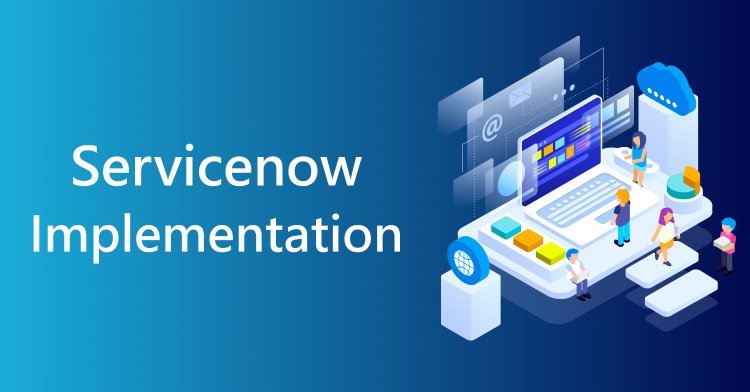How to Plan a Seamless ServiceNow Implementation Project

ServiceNow is a powerful platform for automating workflows, managing IT services, and improving operational efficiency. However, to maximize its potential, a well-structured implementation plan is essential. This guide outlines the key steps to ensure a seamless ServiceNow implementation project.
1. Define Objectives and Scope
The first step in any successful implementation is to clearly define your project’s objectives and scope. This involves:
- Identifying business goals: Understand why you’re implementing ServiceNow. Are you looking to improve IT service management, automate workflows, or enhance customer experiences?
- Outlining deliverables: List the features and modules you plan to implement (e.g., ITSM, HR Service Delivery, CSM).
- Setting boundaries: Define what’s included and excluded in this phase to avoid scope creep.
Engage stakeholders early to ensure alignment and gather their input on requirements.
2. Assemble the Right Team
Your project’s success depends on having the right team in place. Key roles include:
- Project Sponsor: An executive-level champion who ensures organizational buy-in.
- Project Manager: Oversees the project timeline, budget, and communication.
- ServiceNow Developer/Administrator: Handles technical configurations and customizations.
- Process Owners: Define workflows and ensure alignment with business processes.
- End-User Representatives: Provide insights into daily operations to ensure usability.
Consider hiring certified ServiceNow consultants if in-house expertise is limited.
3. Conduct a Thorough Assessment
Before diving into implementation, assess your current processes, systems, and tools. This helps in:
- Understanding existing workflows: Identify inefficiencies and bottlenecks in current processes.
- Auditing current tools: Determine which tools can be replaced or integrated with ServiceNow.
- Gathering data: Collect the necessary data for migration, such as user information, asset inventories, and service catalogs.
This assessment ensures you have a clear picture of your starting point and helps in designing a tailored solution.
4. Develop a Comprehensive Implementation Plan
A detailed plan is the backbone of any successful implementation. Your plan should include:
- Phased approach: Break the project into manageable phases (e.g., discovery, design, build, test, deploy).
- Timeline: Set realistic deadlines for each phase, considering potential challenges.
- Resource allocation: Assign responsibilities and ensure adequate staffing for each phase.
- Risk management: Identify potential risks and develop mitigation strategies.
- Budget: Ensure the project stays within financial constraints, accounting for licenses, training, and unforeseen expenses.
5. Customize with Caution
One of ServiceNow’s strengths is its flexibility, but excessive customizations can lead to complications during upgrades and maintenance. To avoid this:
- Stick to out-of-the-box features: Leverage standard functionalities whenever possible.
- Document customizations: If customizations are necessary, ensure they are well-documented and justified.
- Adopt scalable solutions: Ensure customizations won’t hinder future growth or updates.
6. Prioritize Data Migration
Clean and accurate data is critical for a smooth implementation. Steps include:
- Data cleansing: Remove duplicate, outdated, or irrelevant data.
- Mapping: Ensure data from legacy systems aligns with ServiceNow’s data model.
- Testing: Perform trial migrations to identify and address issues before the final transfer.
Investing time in data preparation reduces errors and enhances system performance.
7. Focus on Change Management
Adopting a new platform like ServiceNow often requires cultural and procedural changes. To facilitate this:
- Communicate benefits: Clearly explain the value of ServiceNow to all stakeholders.
- Provide training: Offer role-based training sessions tailored to administrators, process owners, and end-users.
- Encourage feedback: Create channels for users to share concerns and suggestions.
- Monitor adoption: Track user engagement and address resistance proactively.
Effective change management minimizes disruptions and ensures long-term success.
8. Conduct Rigorous Testing
Testing is essential to identify and resolve issues before deployment. Key activities include:
- Unit testing: Verify individual components and configurations.
- Integration testing: Ensure ServiceNow integrates seamlessly with other systems.
- User acceptance testing (UAT): Involve end-users to validate workflows and usability.
- Performance testing: Assess system responsiveness and scalability under load.
Document test results and address all issues before moving to production.
9. Plan for Deployment and Go-Live
A well-executed deployment ensures minimal disruption to business operations. Steps include:
- Deployment strategy: Decide between a big-bang approach or phased rollout based on organizational needs.
- Final checks: Perform a readiness assessment, including data accuracy and system performance.
- Communication: Notify all stakeholders of the go-live schedule and provide support contacts.
- Post-deployment support: Establish a dedicated team to address issues during the initial weeks.
10. Measure Success and Optimize
Implementation doesn’t end at go-live. Continuous monitoring and optimization are crucial. Focus on:
- Measuring KPIs: Track key performance indicators (e.g., resolution times, user satisfaction).
- Gathering feedback: Regularly solicit input from users to identify improvement areas.
- Updating workflows: Refine processes based on insights and evolving business needs.
- Staying current: Regularly update to new ServiceNow releases to leverage the latest features.
Conclusion
Planning a seamless ServiceNow implementation requires a structured approach, collaboration, and a focus on continuous improvement. By defining clear objectives, assembling the right team, and prioritizing user adoption, you can unlock the full potential of ServiceNow and drive meaningful business outcomes. With the right strategy and commitment, your organization can achieve a smooth transition and long-term success with the platform.
What's Your Reaction?












